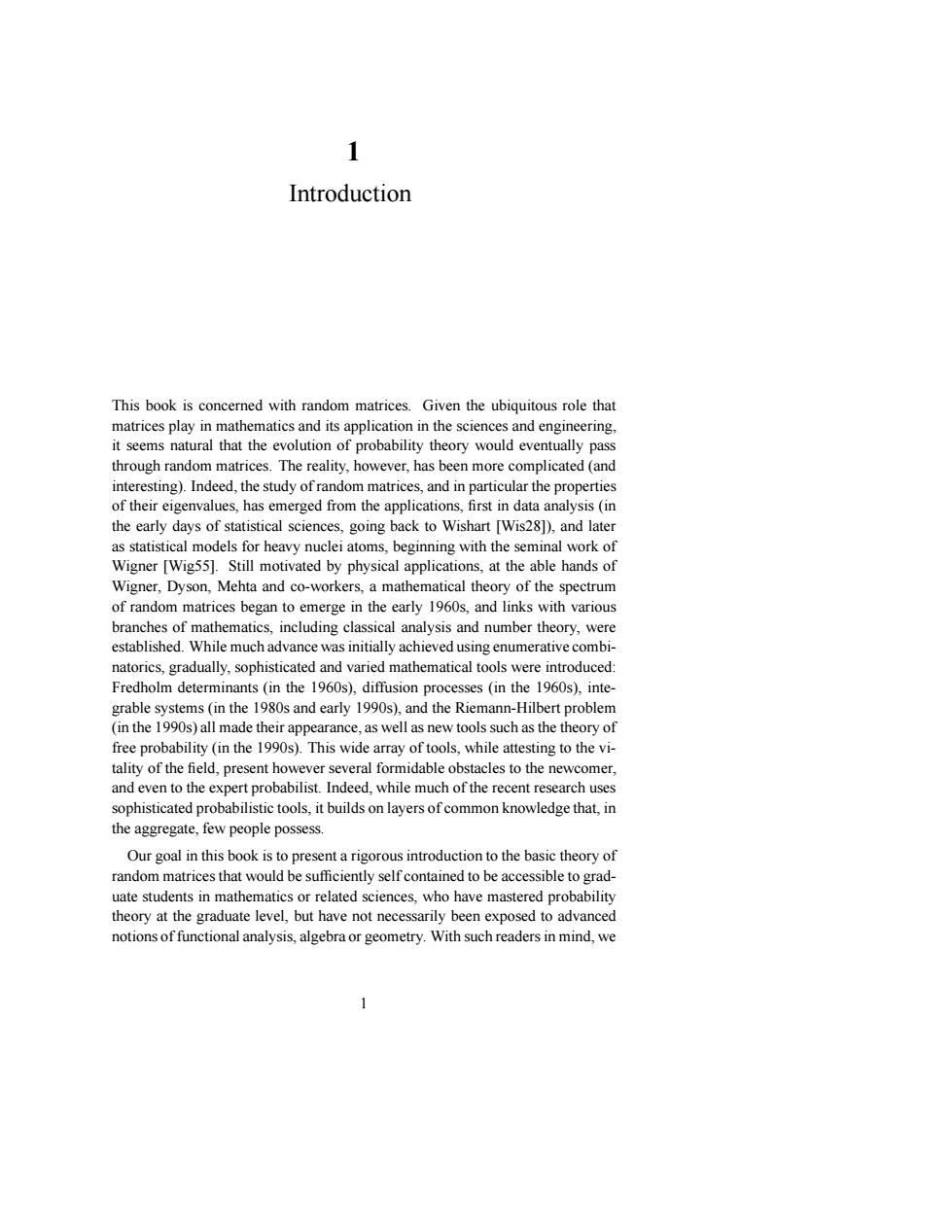正在加载图片...

1 Introduction This book is concerned with random matrices.Given the ubiquitous role that matrices play in mathematics and its application in the sciences and engineering, it seems natural that the evolution of probability theory would eventually pass through random matrices.The reality,however,has been more complicated (and interesting).Indeed,the study of random matrices,and in particular the properties of their eigenvalues,has emerged from the applications,first in data analysis(in the early days of statistical sciences,going back to Wishart [Wis281),and later as statistical models for heavy nuclei atoms,beginning with the seminal work of Wigner [Wig55].Still motivated by physical applications,at the able hands of Wigner,Dyson,Mehta and co-workers,a mathematical theory of the spectrum of random matrices began to emerge in the early 1960s,and links with various branches of mathematics,including classical analysis and number theory,were established.While much advance was initially achieved using enumerative combi- natorics,gradually,sophisticated and varied mathematical tools were introduced: Fredholm determinants(in the 1960s),diffusion processes (in the 1960s),inte- grable systems(in the 1980s and early 1990s),and the Riemann-Hilbert problem (in the 1990s)all made their appearance,as well as new tools such as the theory of free probability (in the 1990s).This wide array of tools,while attesting to the vi- tality of the field,present however several formidable obstacles to the newcomer, and even to the expert probabilist.Indeed,while much of the recent research uses sophisticated probabilistic tools,it builds on layers of common knowledge that,in the aggregate,few people possess Our goal in this book is to present a rigorous introduction to the basic theory of random matrices that would be sufficiently self contained to be accessible to grad- uate students in mathematics or related sciences,who have mastered probability theory at the graduate level,but have not necessarily been exposed to advanced notions of functional analysis,algebra or geometry.With such readers in mind,we1 Introduction This book is concerned with random matrices. Given the ubiquitous role that matrices play in mathematics and its application in the sciences and engineering, it seems natural that the evolution of probability theory would eventually pass through random matrices. The reality, however, has been more complicated (and interesting). Indeed, the study of random matrices, and in particular the properties of their eigenvalues, has emerged from the applications, first in data analysis (in the early days of statistical sciences, going back to Wishart [Wis28]), and later as statistical models for heavy nuclei atoms, beginning with the seminal work of Wigner [Wig55]. Still motivated by physical applications, at the able hands of Wigner, Dyson, Mehta and co-workers, a mathematical theory of the spectrum of random matrices began to emerge in the early 1960s, and links with various branches of mathematics, including classical analysis and number theory, were established. While much advance was initially achieved using enumerative combinatorics, gradually, sophisticated and varied mathematical tools were introduced: Fredholm determinants (in the 1960s), diffusion processes (in the 1960s), integrable systems (in the 1980s and early 1990s), and the Riemann-Hilbert problem (in the 1990s) all made their appearance, as well as new tools such as the theory of free probability (in the 1990s). This wide array of tools, while attesting to the vitality of the field, present however several formidable obstacles to the newcomer, and even to the expert probabilist. Indeed, while much of the recent research uses sophisticated probabilistic tools, it builds on layers of common knowledge that, in the aggregate, few people possess. Our goal in this book is to present a rigorous introduction to the basic theory of random matrices that would be sufficiently self contained to be accessible to graduate students in mathematics or related sciences, who have mastered probability theory at the graduate level, but have not necessarily been exposed to advanced notions of functional analysis, algebra or geometry. With such readers in mind, we 1